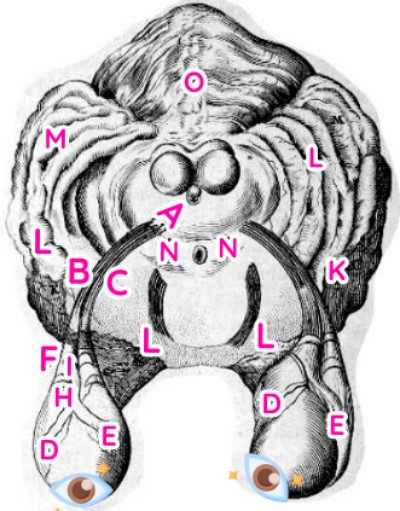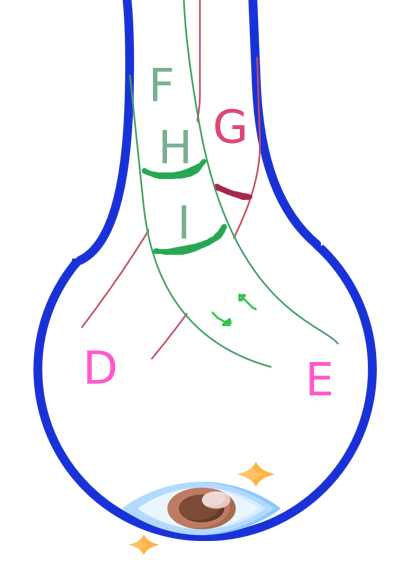How the Animal Spirits Move the Muscles
Table of Contents
The animal spirits in the brain try to enter a nerve and immediately have the power to move a limb.
For example, Nerve A has an outer membrane or sheath that is like a wide tube with several other tubes inside it, such as b, c, k, l, etc., which consist of an inner and thinner sheath.

Both sheaths are continuous with the two, K L, which envelop the brain M N O.

Each of these tubes contains a kind of marrow, which consists of numerous very thin filaments arising from the substance of the brain N, whose ends terminate in different places.
- One part ends on its inner surface facing the ventricles of the brain
- The other part ends in the membranes and flesh where the tube that contains these filaments ends.
This marrow does not cause movement of the limbs, and so it does not fill the tubes in such a way as to leave no room for the animal spirits.
This gives them enough space to flow easily from the brain into the muscles to which these tubes or nerves extend to.
The small nerve B F enters muscle D which moves the eye. That muscle has many small branches enveloped in a loose membrane.
- The aminal spirits divide into those many branches.
- This membrane can expand or contract depending on the amount of animal spirits entering or leaving the muscle.
The muscle swells and contracts when the spirits enter these fibers, pulling the attached eye towards it.
When the spirits exit, the muscle deflates, relaxes, and extends.
Besides the tube B F, there is another tube, E F, through which the animal spirits are conveyed into muscle D and another tube, D G, through which they can exit.

Similarly, muscle E’s function is to move the eye in the opposite direction. It receives animal spirits from the brain through tube C G and from muscle D through G. They are returned to muscle D through E F.
There is no clear passage for the spirits in the muscles D and E to exit, except for where they flow back and forth between each other.
But the particles of these spirits become more and more refined due to their agitation. This allows them to continuously seep through the membranes and parenchyma of the muscles.
However, other spirits flow down through the two tubes B F and C G to replace the lost spirits.
Finally, membrane H F I separates tubes B F and E F. It has 2 valves H and I.
When the animal spirits try to descend from B towards H with greater force than those trying to ascend from E towards I, they depress and open this valve. This allows the spirits in muscle E to quickly flow into muscle D.
But when the spirits trying to ascend from E towards I are stronger, or even if they are equally strong, they lift and close the membrane or valve H F I. This prevents the spirits from exiting muscle E.
If neither side has enough force to pass through the membrane, it naturally remains open.
If the spirits in muscle D try to exit through D F E or D F B, the H valve can expand and block their path.
Similarly, a similar valve is in between tubes C G and D G. This can be closed by the spirits coming from tube D G and opened by those flowing from C G.
If the animal spirits existing in the brain do not flow through B F and C G:
- the two valves
FandGremain partially open or gaping - the two muscles
DandEremain flaccid and inactive.
This is because the animal spirits in them flow freely from one to the other, starting from E through F to D and reciprocally from D through G to E.
However, if the spirits contained in the brain exert a force to enter B F and C G, and the force is equal on both sides, they immediately:
- close both passages
GandF - inflate the two muscles
DandEas much as possible.
As a result, the eye is fixed and remains perfectly still in the same position it initially held.
If the spirits leaving the brain flow with greater force through B F than through C G, they close the membrane or valve G and open F.
The spirits cannot exit from muscle D.
Depending on whether the valve is more or less open, muscle D contracts, while E stretches.
- This causes the eye to turn towards
D.
Conversely, if the spirits leaving the brain flow with greater force through C G than through B F, they close the membrane F and open G.
- In this way, the spirits from muscle
Dimmediately flow back into muscleE. - This causes it to contract and pull the eye towards itself.
These spirits are very similar to a small refined flame.
They rush rapidly from one muscle to another as soon as they are given an exit.
- The mere effort to continue their motion according to the laws of nature is the force that propels them.
These spirits are very mobile and subtle. They can inflate, stretch, and thus harden the muscles they are in.
This is similar to air in a leather bellows:
- makes it more swollen and harder
- stretches the hides it contains.
Whatever has been explained about nerve A and the muscles D and E applies to all other nerves and muscles.